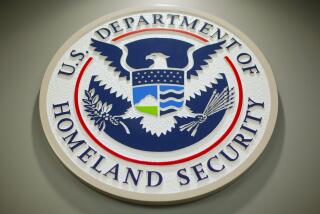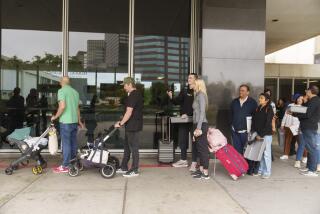U.S. Tightens Checks on Millions of Visitors
WASHINGTON â In a surprise move, the United States will begin fingerprinting and photographing millions of visitors from allied European and Pacific nations who now are exempt from such procedures, Homeland Security Department officials said Friday.
The change is necessary to close a gap in existing security provisions, officials said. But it could aggravate strained relations with traditional allies and invite retaliation against American travelers just as international tourism is recovering from the 2001 terrorist attacks on the United States.
Since January, travelers from most foreign countries have had their digital photographs and fingerprints checked against U.S. security data bases. But 27 so-called âvisa waiverâ countries -- whose citizens do not have to obtain advance permission for most short visits to the United States -- have been exempt.
That will no longer be the case after Sept. 30, Homeland Security Undersecretary Asa Hutchinson said. Hutchinson, who oversees border and transportation protection, said the decision to end the exemption would close what many in the government consider to be a loophole in screening, with minimum inconvenience for arriving visitors.
âThereâs been intelligence that terrorists would look to programs such as the visa waiver program to exploit,â Hutchinson said.
But the change in procedures comes at a time when the war in Iraq has frayed relations with many of the countries whose citizens now will be screened, especially those from Western Europe. And travel industry representatives said they feared some prospective tourists might be offended.
They also expressed concern that countries added to the screening list might impose retaliatory measures on American visitors. Brazil and China are not âvisa waiverâ countries. Soon after the U.S. screening program began this year, Brazil started fingerprinting U.S. travelers, while China imposed added requirements for some Americans seeking visas.
âWeâre concerned thereâs going to be a negative reaction and international visitors will vote with their feet and go elsewhere, where they donât have to be bothered by this,â said Cathy Keefe, a spokeswoman for the Travel Industry Assn. of America.
However, she expressed relief that U.S. authorities would wait until after the busy summer travel season to make the changes. âThis is the first year we expect to see an increase in international travel to the U.S. since 2001,â Keefe said.
State Department spokesman Adam Ereli said the new requirements were âcertainly not intendedâ to offend other countries. âI think everybody recognizes ... security needs,â he said, calling the procedure âa very, very low-hassle, unintrusive way of protecting the public.â
The new screening is part of an existing program called US-VISIT, which stands for United States Visitor and Immigrant Status Indicator Technology. It is intended to bring immigration control into the digital age. Arriving travelers submit to an electronic scan of their right and left index fingers. They also are photographed with a digital camera.
This information and other details about the traveler then are electronically compared with records in government anti-terrorism and crime databases.
The fingerprinting and picture-taking require about 15 seconds, and the database query about 8 seconds, according to the government. About 200 people barred from entering the U.S. have been detained since US-VISIT went into effect for travelers arriving under a visa. Most of those apprehended were felons or fugitives. As yet, no terrorists have been caught.
Canadians will remain exempt from the requirements imposed Friday, as will Mexicans holding a U.S. border crossing card and traveling in border areas for 72 hours or less.
US-VISIT is in effect at 115 airports and 14 seaports, and will be expanded to the 50 busiest land crossings by the end of the year.
Initial reaction from foreign governments was mixed, and it may take several days for responses to develop. U.S. officials briefed foreign embassies in Washington before making the announcement.
A representative of the European Union delegation in Washington said the announcement had come as a surprise, and held out the possibility that some member nations or Europe as a whole might consider imposing retaliatory measures for American travelers.
âWe recognize itâs a two-way street,â Hutchinson said. He said he expected some foreign governments to âkick back,â but added, âWe will work very hard to explain the security benefits of this.â
At the British Embassy, a spokesman expressed confidence in the competence of U.S. authorities. âWeâve got no reason to believe it will affect U.K. travelers coming through U.S. immigration controls in an adverse way,â said the spokesman, who by policy spoke on condition that he not be identified.
The Australian Embassy was less sanguine. âHopefully the system will operate smoothly,â spokesman Matt Francis said.
The expansion of US-VISIT will almost double the programâs workload. In 2002, 13 million travelers from the 27 previously exempt countries arrived at U.S. airports. That compares with 19 million visitors from the 100 or so countries whose citizens already were required to be fingerprinted and photographed.
âThis is a substantial increase in enrollment,â Hutchinson acknowledged, but he also said both the technology and government personnel were ready.
U.S. officials also said that relations between the Bush administration and Congress were in the background of Fridayâs announcement.
Legislation already passed by Congress gave the 27 âvisa waiverâ countries until Oct. 26 to develop high-tech passports that could provide positive identification of the bearer when scanned by an electronic device. Failure to meet the deadline would result in millions more travelers having to apply for visas, complicating visits to the United States and overwhelming the State Department with additional paperwork.
Because of difficulties in developing the high-tech passports, it is widely acknowledged that most of the 27 countries will not be able to meet the October deadline. Later this month, Secretary of State Colin L. Powell and Homeland Security Secretary Tom Ridge will formally ask Congress for a two-year extension of the deadline.
The added scrutiny that now will be required for visitors from Europe and the Pacific is intended as a signal to Congress that security will not be compromised by extending the deadline, officials said.
Hutchinson called it âthe contextâ for his announcement.
More information on US-VISIT is available on the Internet at www.dhs.gov/us-visit.
Separately on Friday, the FBI and Homeland Security warned of a possible terrorist plot this summer targeting bus and rail lines in major U.S. cities. A nationwide bulletin to state and local law enforcement officials was issued Thursday, based on intelligence reports and the attacks last month in Spain.
But officials said the intelligence was uncorroborated and they had no credible evidence of a specific plot.
Local transit agencies have increased security patrols in Washington and other cities, while commuters are being warned to keep an eye out for abandoned backpacks and bags that could conceal a bomb.
Times staff writer Richard B. Schmitt contributed to this report.
More to Read
Sign up for The Wild
Weâll help you find the best places to hike, bike and run, as well as the perfect silent spots for meditation and yoga.
You may occasionally receive promotional content from the Los Angeles Times.






